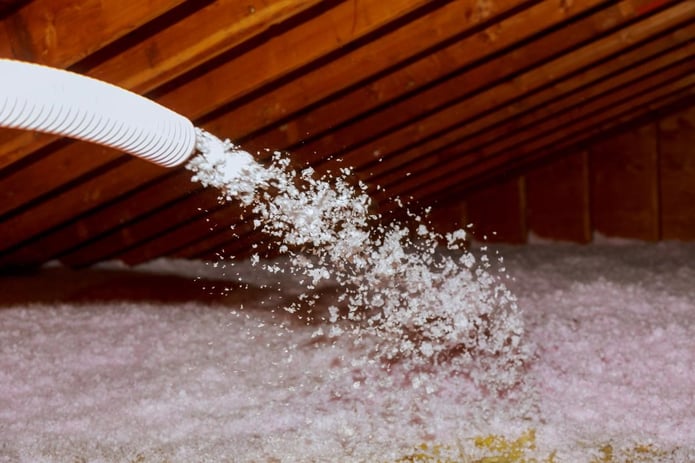If you need new home insulation, you may be wondering whether to choose cellulose or fiberglass. In the following guide, we’ll cover the details of each option and provide a side-by-side comparison of cellulose vs. fiberglass blown-in insulation, so you can make an informed decision.

Choosing the right type of insulation for your home is crucial, especially in a place like Las Vegas, where temperatures often come in at over 100 degrees. Proper insulation not only keeps your home cool during those hot Nevada summers but also helps with energy conservation, saving you money on your electric bills.
What is Cellulose Insulation?
Cellulose insulation is made primarily from recycled paper products and treated with fire retardants. This type of insulation is eco-friendly and provides good thermal performance. It’s heat resistant, has a high R-value (a rating that measures an insulation’s ability to prevent the flow of heat into and out of a home), and is heavily treated with fire-retardant chemicals. It’s also resistant to mold, mildew, and pests and is very affordable.
However, there are some potential disadvantages to consider. This type of insulation can create a lot of dust during installation. It also easily absorbs moisture and is prone to sagging and settling.
What is Fiberglass Blown-In Insulation?
Fiberglass blown-in insulation is made up of fine glass fibers. Unlike many other options, blown-in fiberglass surrounds everything inside the wall cavity, providing a more consistent layer of insulation. It also does not shrink, does not burn, and insects will not eat it. Overall, blown-in fiberglass is an inexpensive and effective option for home insulation.
However, since it is made up of tiny pieces of glass, it’s necessary to wear protective equipment when installing it, as it can irritate both your skin and your respiratory system. It can also settle and sag with time, reducing the R-value. If it becomes wet, the insulation value can also decrease, and you could have an issue with mold growth. Fiberglass is less environmentally friendly than cellulose and it may not effectively fill irregular spaces.
Cellulose vs Fiberglass Blown-In Insulation: Which is Best?
When comparing cellulose vs. fiberglass blown-in insulation, it can be difficult to know which of these two options to choose, since each of them has its own set of pros and cons. Here are a few important things to consider before deciding which type of attic insulation is right for you.
Thermal Performance
Fiberglass and cellulose are both energy-efficient insulation materials. However, cellulose has a slightly higher R-value, which means that it can provide the same amount of insulation as fiberglass while using a thinner layer. Generally, cellulose performs slightly better in extreme temperatures, making it an attractive option for dealing with the Las Vegas heat. While fiberglass is still effective, it may not provide the same level of thermal resistance.
Cost-Effectiveness
Fiberglass is generally less expensive than cellulose when it comes to both the material itself and the insulation costs. This can make it an attractive option for those looking to insulate their homes on a budget.
Longevity
Cellulose is known to pack and settle after installation, which can form pockets that can transfer hot or cold air into your home. On the other hand, fiberglass tends to hold its original shape and form, which typically results in greater longevity. In fact, fiberglass insulation can last over 30 years and often comes with a lifetime warranty.
Safety
While fiberglass is naturally nonflammable, cellulose must be treated with chemicals to make it fire-retardant and resistant to pests. Over time, cellulose can dissipate and turn into dust. When it does, the chemicals can become airborne contaminants that enter your home. When considering cellulose vs. fiberglass blown-in insulation, fiberglass is generally considered a safer material.
Ease of Installation
Both types of insulation require careful installation and it’s always a good idea to leave this job to the professionals. While fiberglass installation requires the use of protective gear, it’s far less dusty than cellulose, which makes it cleaner and easier to install.
The Bottom Line
Depending on your specific needs, budget, and environmental preferences, either cellulose or fiberglass could be the right fit for your Las Vegas home.
If you’re still considering cellulose vs. fiberglass blown-in insulation and are not sure which option best suits your needs, the pros at First Quality Roofing & Insulation are here to help. Contact us today to schedule a consultation.
















